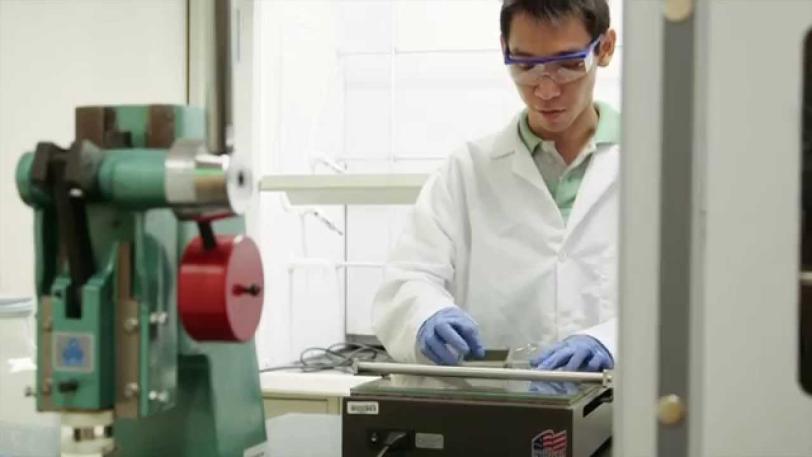A Look Inside SLAC’s Battery Lab
Tucked in a small laboratory at the Department of Energy's SLAC National Accelerator Laboratory, a team of scientists from the Stanford Institute for Materials and Energy Sciences (SIMES) is making and testing new types of lithium-ion batteries. Their goal: create a battery five times better than the ones we use today.
Tucked in a small laboratory at the Department of Energy's SLAC National Accelerator Laboratory, a team of scientists from the Stanford Institute for Materials and Energy Sciences (SIMES) is making and testing new types of lithium-ion batteries. Their goal: create a battery five times better than the ones we use today.

Inside SLAC’s Battery Lab
Stanford graduate student Zhi Wei Seh shows how he prepares prototype batteries in SLAC's energy storage laboratory and then tests them to see how many charge-discharge cycles they can endure without losing their ability to hold a charge.
Lithium-ion batteries work by moving lithium ions back and forth between two electrodes, called the cathode and anode (familiar to most as the "+" and "-" sides of a battery). Charging forces the ions into the anode, storing up energy to power a wide range of devices. Discharging moves the ions back to the cathode. The maximum amount of lithium absorbed by the electrodes determines a battery’s storage capacity.
The lab at SLAC is headed by Yi Cui, an associate professor at Stanford’s School of Engineering and at SLAC, with support from the U.S. Department of Energy's Joint Center for Energy Storage Research (JCESR). Cui believes one key to creating a better battery is making the cathode of sulfur, instead of today’s lithium-cobalt oxide.
Scientists have long known that sulfur can store ten times more lithium than lithium-cobalt oxide and that it’s also much cheaper. But unfortunately, sulfur presents its own challenges. For instance, when lithium ions enter a sulfur cathode during discharging, they bond with sulfur atoms to create a compound that's important for the cathode’s performance. But a portion of this compound then dissolves in the electrolyte, limiting the cathode’s energy capacity. After just a few charge/discharge cycles, these unwanted reactions greatly degrade the battery.
To solve this problem, the SLAC/Stanford research team devised a clever solution, called a yolk-shell design. Individual nano-nuggets of sulfur, each one-hundredth the diameter of a human hair, are enclosed within a semi-porous shell that allows lithium ions to pass through but blocks the electrolyte. Making the shell somewhat larger than the nanoparticle allows the sulfur to swell and contract as it absorbs and releases lithium during charge/discharge cycles without dissolving.
The research being done at SLAC aims to optimize the process for making yolk-shell structures and to match the sulfur cathode with a silicon anode, being developed in a companion SIMES laboratory on the Stanford campus, that can store much more energy than today’s anodes. The team's prototypes have already set records for these types of batteries, but need more research before they'll be ready for the commercial market.
Nonetheless, sulfur cathode results have been very promising and many teams around the world are now testing them. If their success continues, it may be only a few years before these experiments take energy storage beyond today's lithium-ion to the next generation of batteries.
SLAC is a multi-program laboratory exploring frontier questions in photon science, astrophysics, particle physics and accelerator research. Located in Menlo Park, Calif., SLAC is operated by Stanford University for the U.S. Department of Energy's Office of Science.
The Stanford Institute for Materials and Energy Sciences (SIMES) is a joint institute of SLAC National Accelerator Laboratory and Stanford University. SIMES studies the nature, properties and synthesis of complex and novel materials in the effort to create clean, renewable energy technologies. For more information, please visit simes.slac.stanford.edu.
The Joint Center for Energy Storage Research (JCESR) is a major partnership that integrates researchers from many disciplines to overcome critical scientific and technical barriers and create new breakthrough energy storage technology. Led by the U.S. Department of Energy’s Argonne National Laboratory, partners include national leaders in science and engineering from academia, the private sector, and national laboratories. Their combined expertise spans the full range of the technology-development pipeline from basic research to prototype development to product engineering to market delivery. Funding for JCESR is provided by the U.S. Department of Energy's Office of Science. For more information, please visit jcesr.org.
SLAC National Accelerator Laboratory is supported by the Office of Science of the U.S. Department of Energy. The Office of Science is the single largest supporter of basic research in the physical sciences in the United States, and is working to address some of the most pressing challenges of our time. For more information, please visit science.energy.gov.






